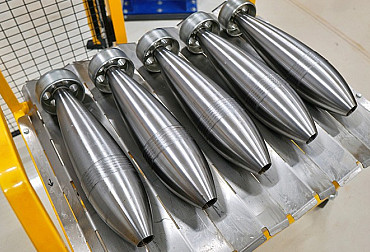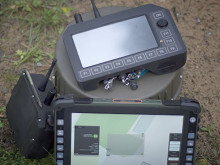The last Leopard 2A4 tank donated by Germany has arrived in the Czech Republic
The last of the 14 Leopard 2A4 battle tanks donated in support of Ukraine has arrived in the Czech Republic from Germany.First Deputy Minister of Defence František Šulc announced this at yesterday's Command Assembly of the Chief of the General Staff of the Czech Army in Prague, adding that the 73rd Tank Battalion received the last one a few days ago. The Czech Republic received the first of the donated Leopards last December. The only thing missing from the complete delivery is a Büffel recovery vehicle on a Leopard 2 chassis, which will arrive next year. In his speech, Šulc also highlighted the Czech role within the North Atlantic Alliance and the need for further recruitment to the Czech Army.

The gift worth almost four billion crowns, which started the transition of the Czech Armed Forces from eastern to western tank technology, is compensation for the continuous support to Ukrainian defenders since the beginning of the invasion of the Russian aggressor. In addition to the tanks themselves (14 Leopard 2A4 tanks and 1 Büffel recovery vehicle), the delivery also includes an initial package of spare parts, ammunition and three years of service support from the supplier, which includes training of Czech soldiers.

According to First Deputy Defence Minister František Šulc, the gift also deepened relations with Germany and Austria. "I call it 'the story of the Leopard 2A4 tank' because cooperation has developed around this one tank not only with Germany, but also with Austria, for example. One tank was able to literally kick our relations to a new level, and in a year and a half we have moved further than we have in decades. This is with our biggest neighbour, with whom we are connected by an economic, cultural and historical umbilical cord," František Šulc said in his speech, adding that cooperation with Germany does not end here. "At the same time, we are negotiating with it to join the purchase of the most modern 'eight' Leopards. We are serious about the heavy brigade," Šulc added.
The need to acquire new modern tanks has long been recognised by representatives of the Czech Armed Forces. In April this year, the Chief of the General Staff told the defence committee that modern tanks should enter the armament of the 73rd Tank Battalion in 2027-2030. At that time, the army was preparing a feasibility study, on the basis of which, on 24 May, the government authorised Defence Minister Jana Černochová to start negotiations with Germany on the joint purchase of up to 77 Leopard 2A8 tanks in six variants (combat, command, recovery - Büffel, engineer - Kodiak, bridge - Leguan, and for driver training). Together with the aforementioned 14 donated Leopard 2A4 tanks and one Büffel recovery tank, this brings the total to 92 tanks, of which 60-70 are combat tanks. With their arrival, for a long time the period of provisioning, when our tankers were struggling with the low operability of T-72M4 CZ tanks, which had to replace the obsolete T-72M1 tanks in service, will come to an end.
Video: Leopard 2 tanks in the Czech Armed Forces and LEOBEN Club benefits / CZ DEFENCE
The decision announced at the end of May thus ended a long period of speculation. Although the German Leopard 2 had been the obvious favourite from the beginning of the considerations on the rearmament of the tank battalion, there were at least two other solutions that the army had to evaluate responsibly, namely the American Abrams tanks, which are coming into the Polish army's armoury in the order of the lower hundreds, and the South Korean K2 Black Panther tanks, of which the Poles have purchased a thousand and are preparing their mass production on Polish territory. Apart from the excellent tactical and technical parameters of the Leopard 2 tank, another advantage is its spread in the armament of the allied armies (Germany, Austria, Denmark, Finland, Greece, Poland, the Netherlands, Norway, Spain, Sweden, Switzerland, Canada, Turkey, and now also Hungary, Czech Republic or Slovakia), the good experience over decades of service of this platform, which still has significant modernisation potential, and last but not least the geographical proximity of its production and service base - the Munich-based Krauss-Maffei Wegmann (KMW).

Other modernisation projects of the ACR are in process
"The previous government, and it has to be admitted that the purchase was welcomed by the Minister, then as chairwoman of the committee, even from the opposition benches, purchased 12 modern H1 helicopters.However, we managed to negotiate another eight machines as a gift from the USA, also in return for our assistance to Ukraine," Šulc continued during the Command Assembly of the Chief of the General Staff of the Czech Army on the topic of other acquired equipment. "The government has recently decided on the future and modernisation of our supersonic air force, whereby we are acquiring two squadrons of the most advanced fifth-generation supersonic aircraft, the US F-35, on the basis of an army recommendation, i.e. an expert recommendation. This is a comprehensive project that will take our entire army into the future," Šulc stressed the importance of another major future acquisition.
"I know that you have heard a lot of promises, but I believe that now promises are turning into actions and you all see that. For example, after years of delays, we have managed to sign a contract for Swedish CV90 infantry fighting vehicles, the production of which will also involve the Czech defence industry," the First Deputy Minister of Defence then highlighted further expected cooperation.
The Czech Republic has gone from a passive member of the Alliance to a very active one
František Šulc also recalled the close and important relations within NATO. "Under this government, the Czech Republic has gone from being a passive member of the Alliance to a very active one that wants to fulfil its commitments and deepen its relations with its allies. We are also repairing relations at the bilateral level, for example, I will mention the DCA agreement with the United States, which was signed by the Minister this spring," continued the 1st Deputy Minister of Defence, recalling hybrid threats, including cyber attacks and the use of energy dependence as a weapon.
Czech Republic sent equipment worth CZK 1.2 billion to Ukraine
Based on declassified material from the Ministry of Defence, it appears that the Czech Republic has so far donated military equipment to Ukraine for approximately CZK 1.2 billion, which is the residual value of the supplies, until 9 October 2023. The purchase price of all items was 6.2 billion. This includes 4 pieces of aviation equipment, 62 tanks, 131 infantry fighting vehicles, dozens of pieces of specialised vehicles and cars, over 80 thousand pieces of ammunition for guns and howitzers or over four million rounds of ammunition for small arms. In addition to the aforementioned rewards for aid to Ukraine from Germany and the US, the Czech Republic is expected to receive €78 million between 2022-2027 under the European Peace Facility, which is used to fund EU defence and security priorities.
Working with and recruiting people is key
"Our work is not over. The acquisition of systems is useless without their implementation, without sufficient ammunition and trained personnel. We have to constantly prove to the public that investment in defence is effective, we have to explain that this is not some haphazard contrivance, but a meaningful use of public funds to protect our country and its citizens. We must not squander the trust we have," František Šulc continued his speech at the Commanders' Assembly of the Chief of the General Staff of the Army of the Czech Republic, emphasising the civilian part of the ministry and the support of colleagues who do not wear the uniform.
"It is not only about the most visible tasks. Other things are also key. First of all, working with people and recruiting them. Without people, state-of-the-art technology is useless. Improve working conditions, digitise and remove unnecessary bureaucracy, communicate more and better, introduce new technologies to make work easier, such as artificial intelligence and other breakthrough technologies. It sounds obvious, but it is often more challenging than acquiring and deploying the most advanced weapons system," the 1st Deputy Defence Minister emphasised towards the end of his speech, adding that the security situation in the world is the worst in 30 years and the world order is facing attacks from all sides, he said. In addition to the conflict in Ukraine, František Šulc also mentioned the new war in the Middle East and the threat of Hamas terrorists.
The importance of quality staffing was also confirmed in his speech by the Chief of the General Staff of the Army of the Czech Republic, Gen. "Our problem is not only modernization. The purchase of material alone does not solve anything. It will only work in conjunction with quality soldiers and commanders, good training and adequate doctrine. Along with equipment and materiel, morale, training, leadership, mindset, concepts and doctrine are equally important. The worst thing would be to get too complacent about new technology or to wait passively for it."
General Rehka's speech also highlighted the main tasks for the coming year, "My main priority is and will continue to be combat capability. The security situation demands that we achieve combat capability and an order of magnitude higher level of readiness than we have been used to in the past. And we need to achieve this quickly. I am deadly serious! Each of us must feel the urgency and do what we can with what we have. Personal initiative at all levels is key! We will continue to work on deterrence and defense. We are preparing for the worst-case scenario, a high-intensity, large-scale war with a technologically advanced adversary equipped with nuclear weapons. Thankfully, our country will deter and defend itself as part of NATO. That is why the approved Alliance regional defence plans are the basic starting point for building and preparing the army."





















